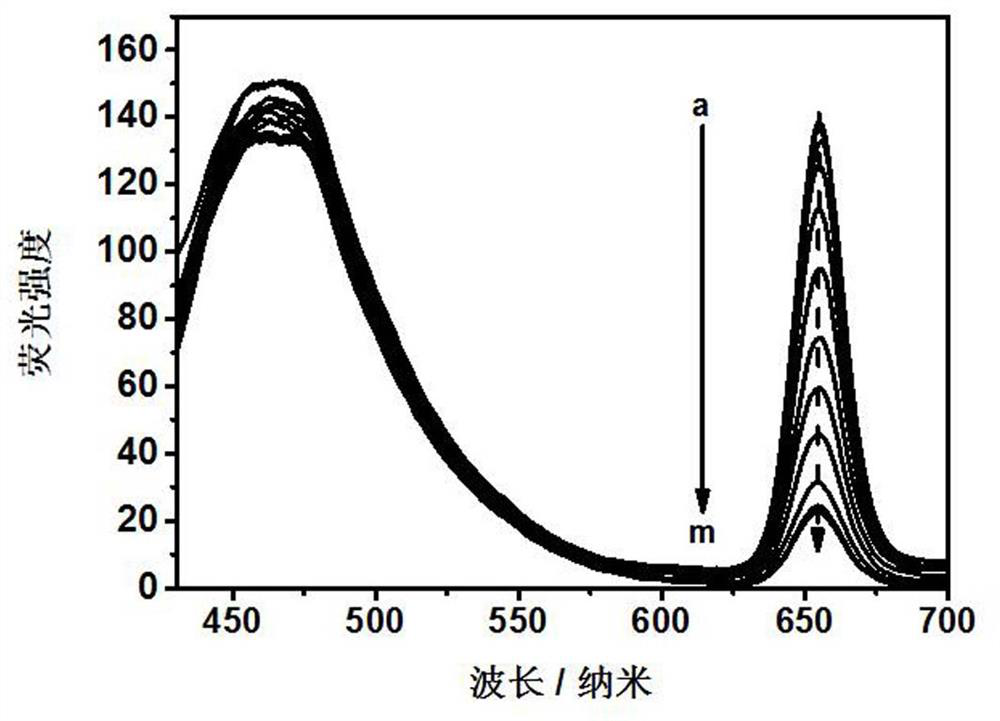A polymer fluorescent sensor, preparation method and application based on porphyrin-based ratiometric detection of hypochlorite
A technology for detecting hypochlorous acid and fluorescence sensors, which is applied in chemical instruments and methods, fluorescence/phosphorescence, luminescent materials, etc., can solve problems such as the interference of biological autofluorescence, and achieve the effects of stable dispersion, simple preparation and high sensitivity
- Summary
- Abstract
- Description
- Claims
- Application Information
AI Technical Summary
Problems solved by technology
Method used
Image
Examples
Embodiment 1
[0043] A preparation of a polymer fluorescent sensor based on porphyrin-based ratiometric detection of hypochlorite, the specific steps are as follows:
[0044] (1) 5-(hydroxyphenyl)-10,15,20-phenylporphyrin (0.1 mmol), 2-methyl-2-(((propylthio)carbonylthio)thio)propane Acid (0.5 mmol), 4-dimethylaminopyridine (0.15 mmol), N,N'-diisopropylcarbodiimide (0.75 mmol) were dissolved in dichloromethane according to the molar ratio, and stirred at room temperature for 18 hours Finally, the reaction solution was washed with distilled water to remove N,N'-diisopropylcarbodiimide, and the product was purified by column after rotary evaporation and vacuum-dried to obtain compound 1.
[0045] (2) Dissolve compound 1 (0.02 mmol), styrene (3.5 mmol), and azobisisobutyronitrile (0.005 mmol) synthesized in step (1) in 1 mL of dimethylformamide (DMF), and vacuumize - Circulate three times with nitrogen gas and then rapidly raise the temperature to 90° C. for 6 h. After the reaction, precipita...
Embodiment 2
[0050] A preparation of a polymer fluorescent sensor based on porphyrin-based ratiometric detection of hypochlorite, the specific steps are as follows:
[0051] (1) 5-(hydroxyphenyl)-10,15,20-phenylporphyrin (0.1 mmol), 2-methyl-2-(((propylthio)carbonylthio)thio)propane Acid (0.3 mmol), 4-dimethylaminopyridine (0.05 mmol), N,N'-diisopropylcarbodiimide (0.5 mmol) were dissolved in dichloromethane according to the molar ratio, and stirred at room temperature for 12 hours Finally, the reaction solution was washed with distilled water to remove N,N'-diisopropylcarbodiimide, the product was purified by column after rotary evaporation, and dried in vacuum to obtain compound 1;
[0052] (2) Dissolve compound 1 (0.02 mmol), styrene (2 mmol), and azobisisobutyronitrile (0.004 mmol) synthesized in step (1) in 0.5 mL dimethylformamide (DMF), and vacuumize - Circulate three times with nitrogen gas and then rapidly raise the temperature to 80°C for 4 h. After the reaction, precipitate wit...
Embodiment 3
[0057] A preparation of a polymer fluorescent sensor based on porphyrin-based ratiometric detection of hypochlorite, the specific steps are as follows:
[0058] (1) 5-(hydroxyphenyl)-10,15,20-phenylporphyrin (0.1 mmol), 2-methyl-2-(((propylthio)carbonylthio)thio)propane acid (1 mmol), 4-dimethylaminopyridine (0.2 mmol), N,N'-diisopropylcarbodiimide 1.5 mmol) were dissolved in dichloromethane according to the molar ratio, and stirred at room temperature for 24 hours , wash the reaction solution with distilled water to remove N,N'-diisopropylcarbodiimide, then rotatively evaporate and pass the column to purify the product, and dry it in vacuum to obtain compound 1;
[0059] (2) Dissolve compound 1 (0.02 mmol), styrene (5 mmol), and azobisisobutyronitrile (0.006 mmol) synthesized in step (1) in 2 mL of dimethylformamide (DMF), and vacuumize - Circulate three times with nitrogen gas and then rapidly raise the temperature to 100°C for 8 h. After the reaction, precipitate with meth...
PUM
 Login to View More
Login to View More Abstract
Description
Claims
Application Information
 Login to View More
Login to View More - R&D
- Intellectual Property
- Life Sciences
- Materials
- Tech Scout
- Unparalleled Data Quality
- Higher Quality Content
- 60% Fewer Hallucinations
Browse by: Latest US Patents, China's latest patents, Technical Efficacy Thesaurus, Application Domain, Technology Topic, Popular Technical Reports.
© 2025 PatSnap. All rights reserved.Legal|Privacy policy|Modern Slavery Act Transparency Statement|Sitemap|About US| Contact US: help@patsnap.com



